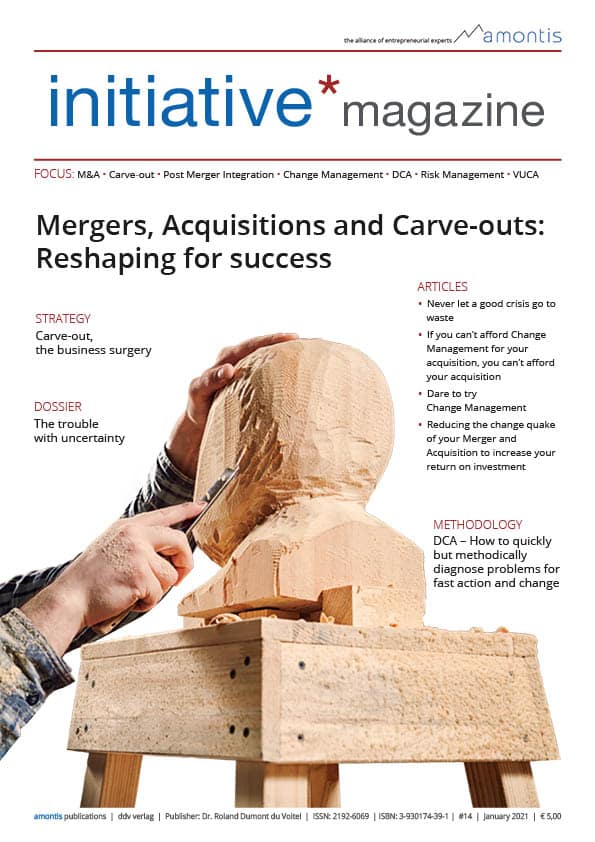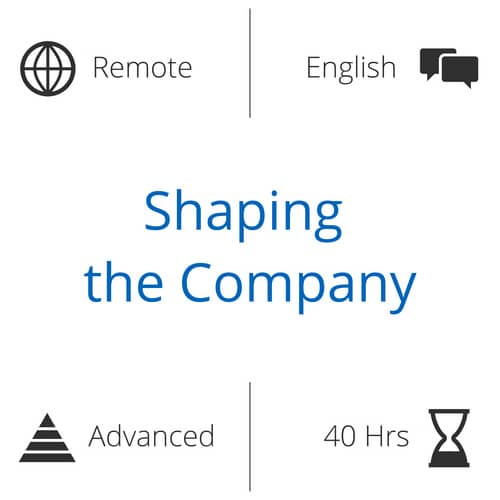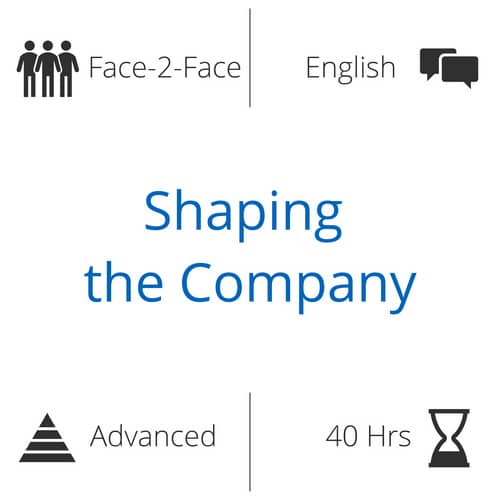The future is uncertain – not only due to COVID-19 but by nature. Uncertainty triggers fear. Good things could happen, bad things could happen… The truth is usually a “bit of both” and depends on the perspective.
Opportunities and threats are the two sides of the same coin called “uncertainty”. However, for the sake of pure survival – the key aim we share among all living species – we tend to pay a lot more attention to threats than to opportunities.
Here is the second part of our article (if you missed the first part, you can read it here)

This article has been first published in our initiative*magazine #14: „Mergers, Acquisitions and Carve-outs: Reshaping for success“ (free download).
Authors:
FEDERICO AVELLÀN BORGMEYER | ARLETTE DUMONT DU VOITEL | HUGO VON LIECHTENSTEIN | NILS SCHÄFER
Table of Contents
Case #2:
The Sony effect: Making competitors to customers
The sector of photography and imaging, however, also provides for good examples of dealing with disruption and leveraging resulting opportunities. Sony has reinvented itself many times surviving major disruptions in its industry and recovering from the decline of flagship products such as the Walkman.
This Sony story begins with M&A. In 2006 Sony acquired the photography carve-out of Konica Minolta and, thus, entered the digital photography market for good. Today, Sony is the market leader and key supplier of camera sensors – even for long term market rivals and leaders such as Nikon. Many people, especially photography enthousiasts, rub their eyes in amazement when they find out that Nikon does not develop the sensors for its flagships itself. Why would Nikon do this?
Some may remember that Sony experienced serious economic difficulties between 2010 and 2012. Once again, the crisis was the main reason for the strategic opening. In 2012 Sony finally saw the market opportunity and started to sell more and more of its sensors to third parties, mainly smartphone manufacturers, and thus developed into a sensor supplier of the rapidly developing smartphone industry. As a supplier of a fastpaced sector, Sony had to rethink or redesign its products due to the constantly changing and new requirements, which significantly strengthened the company’s innovative strength.
While other camera manufacturers kept their focus on large sensors and conducted extensive research, Sony was able to gain a lot of experience through continuous, incremental improvements of the very small sensors for the smartphones. This was easier, cheaper and, above all, faster. Sony then simply converted the results to larger sensors. The sensor business in the smartphone industry enabled Sony to increase its sales immensely, freeing up considerable financial resources for research and development. Sony’s role as a supplier to the smartphone manufacturers provided it with a very different set of opportunities from other camera manufacturers. And this is of course reflected in the results: Sony is not only the world market but also the technology leader with its sensors.
There is hardly any other camera manufacturer that can catch up in the short- or medium-term with Sony in terms of its technology. To remain marketable and develop attractive technology, these other camera manufacturers’, such as Nikon, best immediate move was to enter a strategic partnership with Sony and to gain access to the latest sensors.
This article was first published in our initiative*magazine #14:
„Mergers, Acquisitions and Carve-outs: Reshaping for success“
How can “anticipatory thinking” help in this situation?
How can “anticipatory thinking” help in this situation?
One thing that can be learned from this case is that an acquisition is not (only) for short-term benefits but requires a dedicated vision and strategy for the future of the joint business. When Konica Minolta decided to carve-out its photography unit and sell it to the then partner Sony, the latter was only represented in the digital camera market with its Cybershot line – compact point-and-shoot digital cameras for amateurs – and was entirely new in the professional or prosumer market.
Sony still achieved what the traditional photography business Minolta failed to accomplish: It caught up with the digital market leaders Nikon and Canon. With its own starting point being the Cybershot range, Sony wouldn’t have been able to enter the professional market so quickly without the purchase of Konica Minolta – and its sensor success story may also have been a different one without Konica Minolta.
As already outlined, for the other camera manufacturers, there are two main options to deal with this competitive advantage in the longer run: Catch up with and overtake Sony’s technology or remain in partnership and create a competitive advantage in another area. After all, a camera consists of more than just a sensor.
Both broad scenario directions would benefit from the expertise of others – whether this is a partnership, a merger or an acquisition or the investment into a start-up or a new ecosystem.
Case #3:
The crisis: When low probability but high impact risks materialise
COVID-19 has shown us once again that disruption and turmoil can also be caused by factors that are external to the business world. A pandemic is an example of an extreme risk. This is a risk with a known probability of occurrence of 0.1-1% per year2. As a matter of fact, there have been pandemics before. Therefore, Corona is not considered a “black swan”, which describes events that are so rare that even the possibility of their occurrence is unknown. This has an implication for stock corporations and firms trading under the legal form of a GmbH, which corresponds to the private limited company status (ltd.), that many executives don’t seem to be aware of. By law, or more specifically the German § 91 AktG., German stock corporations and GmbHs should have been prepared for the Coronavirus outbreak as part of their risk management and detected it as “development threatening the existence of the company” early on3.
The wave of insolvencies witnesses the fact that this hasn’t been the case in many instances. But even for “black swan” events, Nassim Nicholas Taleb, a finance professor, writer, and former Wall Street trader who came up with the term and the according concept, stresses the importance for organisations to always take a black swan event as a possibility, and although the nature, timing and consequence of the event is entirely unknown, to try to consider it in organisational risk and opportunity management plans4.
These investments may help us through this crisis but a probability
of occurrence of 0.1-1% also describes a scenario where two pandemics occur in one single year and then there is none for the next 100 years. So the next one could be around the corner – not to speak of other external risks and black swans that may appear in addition. There aren’t endless governmental financial lifelines to cater for all these eventualities. Companies need to collect the lessons learned from this crisis and act upon them.
1. Refer to Part 1 of the article and + 1. Klein, G., Pin, C. L., and Snowden, D. (2011). Anticipatory Thinking. Available at:
https://www.researchgate.net/publication/228953044_Anticipatory_Thinking/ (Accessed 21.06.2021).
2. Bundesdrucksache 17/12051
3. Gleißner, W. (2019). Wertorientierte Unternehmensführung, Strategie und Risiko, https://www.amazon.de/dp/B07TYZ2FZV/
4. Taleb, N.N. (2007). The Black Swan: The Impact of the Highly Improbable. Random House (U.S.) Allen Lane (U.K.)
How can “anticipatory thinking” help in this situation?
The realisation that companies (and governments) could and should have been prepared for a pandemic is a retrospective view that helps with two things: legal actions and lessons learned for a future-oriented perspective. The latter is of relevance in this context. Conscious anticipatory thinking can be used as a practical and functional approach of integrating risk and opportunity management as well as effective decision making into everyday business practice to work with uncertainties. This is of great support to any early warning system and promotes fast (re-) action. Extreme risk events, such as the Corona pandemic, require an additional dedicated effort as a legal necessity as well as one of survival. There are systematic steps for the development of an appropriate corporate security concept that builds upon anticipatory thinking.
The starting point is to use the research findings on past crisis in order to model possible scenarios for upcoming ones in an interdisciplinary manner. Once the scenarios are developed, these can be applied in order to anticipate the effects of the crisis on demand, interest rates, inflation and the loss of important customers and suppliers (e.g. due to insolvency). This again allows to model how these outcomes will affect integrated corporate planning (P&L, balance sheet and cash flow) taking into account the effects that are already visible in the crisis and the planned or already initiated coping measures (e.g. short-time work – government supported partial unemployment).
The described analysis of the crisis and its implications for one’s own company shows the degree of threat to the continued existence of the company (the insolvency risk or rating), the risk-dependent liquidity requirements and evaluates the combined effects of risks, which is also central in fulfilling the legal requirements for a risk management system based on the § 91 AktG.
This is the foundation for the next step, which is to model one or more scenarios that ensure the survival of the firm for the next three years with a high degree of certainty (e.g. of 95%), as well as to define the measures to be taken in order to realise this level of certainty. This degree or level of certainty is to be individually defined for each organisation depending on their “risk appetite”. “Anticipatory thinking” may act as the progressive elaboration of the according roadmap.
How can “anticipatory thinking” help in this situation?
As already mentioned in the previous cases, M&A is a shaping tool for businesses, in particular if time is limited. When it comes to modelling future scenarios to ensure the survival and well-being of the firm, it is wise to take the options and effects (positive and negative) of a partnership, merger, acquisition, carve-out or spin-off into consideration. This is true for the everyday uncertainties, business and market dynamics – and even more so in times of crisis as these options may very well be the key to open up a new road towards a more certain, robust and resilient business situation. While the emphasis of M&A strategies is on fast action, transformation and change, it is to be stressed once again in the context of all the above-mentioned cases that M&A is never a quick win or an instant solution. The purpose for M&A needs to be clear in order to choose the appropriate form of combining or separating forces and to design a good strategy and actions to move forward together or independently, respectively. Anticipatory thinking helps organisations to engage in future scenario modelling, to prepare for possible threats and opportunities along the way and to remain flexible in order to adapt quickly if need be. Once this thought process has been trained and repeated often enough, anticipatory thinking becomes second nature, an automated behaviour, in an organisation and among its people leading to faster and better (re-) actions to surprise events overall (good or bad) in the same way as an experienced driver perceives a hazard quicker and tends to react more effectively then a newly licensed one. In many instances, in which a threat or an opportunity requires far-reaching changes and the subsequent organic transformation needed would be too slow to be efficient, M&A (including carveouts and spin-offs) is a very viable scenario to pursue. The success of these ventures depends on the level of readiness and preparation of an organisation to enter them, on having a clear purpose for the merger, acquisition, carveout or spin-off as well as on the design and implementation of the roadmap for the time “after the fact”, the so-called post-merger or acquisition phase. This includes conscious strategic decisions, for example to integrate an acquired start-up into a traditional organisation or to keep it separate and let it grow organically as outlined in the first case of this article. But it also encompasses the overall change strategy and management in the short-, medium- and longer term. And it should always contain alternative options or an exit plan in case there is a real black swan suddenly appearing on the horizon.
In the meantime, amontis will gladly guide through your Merger and Acquisition activities. The first talk is free of charge.
How can we help for your M&A activities?
amontis has many years of experience of helping companies to successfuly close merger and acquisitons deals and to harmonise differen corporate cultures.
Learn more here: www.amontis.com/mergers-and-acquisitions
We also design special trainings to give you the best knowledge and tools to carry on successfuly with your M&A, Carve-out or Post-Merger-Integration activities:
If you need further consultancy, just get in touch with us – our first conversation is free of charge.
Interested in content like this?
Subscribe now!
Newsletter
About the authors

Federico Avellàn Borgmeyer
Federico is managing the change on digital transformation along with new (digital) business models. He uses advanced technologies, i.e. AI/Machine Learning or Blockchain, where appropriate, he restructures where needed, or consults on M&A or Financing where required.

Arlette Dumont du Voitel
Arlette ist Managing Partner der amontis consulting ag und Consultant, Interim Manager, Trainer und Coach in allen Bereichen des Change und Projektmanagements.

Hugo von Liechtenstein
Starting in 1999, Hugo built and ran the „Acquisition Finance“ team at Crédit Lyonnais‘ Frankfurt office, until he left in 2004 to launch his own consultancy company. His main focus during the time at Crédit Lyonnais was the structuring of LBO/MBO financings for private equity firms in Germany, Austria and Switzerland.

Nils Schäfer
Nils Schäfer is an industrial engineer and consultant at amontis. In addition to his technical and economic education and project experience in lean and process management topics, he is studying ethnology and philosophy alongside his consulting work in order to be able to grasp and effectively address the human and multicultural aspect in projects.













